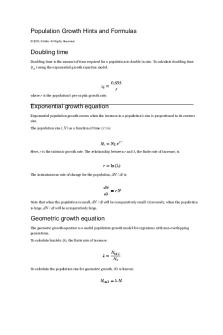Population Growth - PDF

| Title | Population Growth - |
|---|---|
| Course | Calculus For The Life Scie II |
| Institution | East Carolina University |
| Pages | 1 |
| File Size | 29.3 KB |
| File Type | |
| Total Views | 142 |
Summary
...
Description
PROBLEMS ON POPULATION GROWTH
(1) Consider a forest with a population of deer. The deer have an annual birth rate of 0.8, and an annual death rate of 0.77. Each year 150 deer move into this forest from adjoining areas, and 200 deer move out of the forest. Set up a differential equation which shows how the population is changing over time. Let y be the number of deer, and let t represent time measured in years. Do not solve the differential equation. (2) Differential Island supports one species of finch. The birth rate of this species is 0.68 births per finch per year, and the death rate is 0.54 deaths per finch per year. Each year 12 finches fly to Differential Island from neighbouring islands, and 8 finches fly away. Set up a differential equation which shows how the population of finches is changing over time. Let y be the population, and t be time measured in years since 1980. If there were 500 finches in 1980, how many are there this year? (3) The growth rate of a population of parrots is 0.07 (time measured in years). Each year 5 parrots fly into this population from outside. In 1995 there were 200 parrots. Write down the differential equation which describes the growth of this population. Solve this differential equation. When will the number of parrots reach 400? (4) The growth of a population is described by the differential equation dy y , = 8y 1 − dt 400 where y is the population and t represents time in years after 2015. (a) What is the carrying capacity of the environment? (b) What is the growth rate when the population is small? (c) Write down the solution of the differential equation, assuming that the population was 100 in the year 2015. (d) When will the population reach 200? (5) A snail species has a limiting population of 10, 000. When the population is small, it grows at an annual rate of 2.3. Write down the logistic differential equation which best describes the growth of this population. (6) The growth of a population is described by the differential equation dy y y = 8y 1 − −1 , 100 500 dt (a) What is the carrying capacity of the environment? (b) What would happen if the population were 200? (c) What would happen if the population were 700? (d) What would happen if the population were 50?...
Similar Free PDFs

Population Growth -
- 1 Pages

Population Genetics
- 6 Pages

Research Population
- 3 Pages

Atypical Growth
- 1 Pages

Growth & Development
- 4 Pages

Population Kaplan review
- 10 Pages

Population Dynamics Simulation
- 8 Pages

Global Population and Mobility
- 4 Pages

Population Ecology Notes
- 11 Pages
Popular Institutions
- Tinajero National High School - Annex
- Politeknik Caltex Riau
- Yokohama City University
- SGT University
- University of Al-Qadisiyah
- Divine Word College of Vigan
- Techniek College Rotterdam
- Universidade de Santiago
- Universiti Teknologi MARA Cawangan Johor Kampus Pasir Gudang
- Poltekkes Kemenkes Yogyakarta
- Baguio City National High School
- Colegio san marcos
- preparatoria uno
- Centro de Bachillerato Tecnológico Industrial y de Servicios No. 107
- Dalian Maritime University
- Quang Trung Secondary School
- Colegio Tecnológico en Informática
- Corporación Regional de Educación Superior
- Grupo CEDVA
- Dar Al Uloom University
- Centro de Estudios Preuniversitarios de la Universidad Nacional de Ingeniería
- 上智大学
- Aakash International School, Nuna Majara
- San Felipe Neri Catholic School
- Kang Chiao International School - New Taipei City
- Misamis Occidental National High School
- Institución Educativa Escuela Normal Juan Ladrilleros
- Kolehiyo ng Pantukan
- Batanes State College
- Instituto Continental
- Sekolah Menengah Kejuruan Kesehatan Kaltara (Tarakan)
- Colegio de La Inmaculada Concepcion - Cebu






